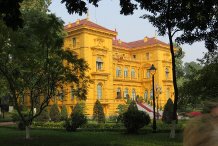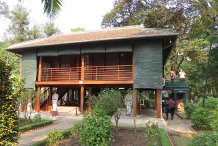Having visited the same country with my wife in February 2015, I could relate to Susan Rogers’s account of her journey to Vietnam 11 years earlier. The main differences were the direction of travel (in our case, from North to South) and more importantly the fact that, while we were on a package holiday, Susan travelled solo.
She didn’t choose to do so. “How many people will you have in the tour group?” she asked the guide who met her at the airport in Ho Chi Minh City. “One,” he replied, “You.”
“There were definitely mixed feelings about being the only person,” she told us. “I knew that travelling by myself meant that I would have nobody to share the memories of the holiday afterwards, but I had expected to have other people to talk to, other people to dine with and other people to share the holiday experience with.”
Her fears quickly proved to be groundless, despite the fact that she arrived in Saigon on December 20 and had no travelling companions to share the Christmas festivities, with the accompanying feasts of local cuisine.
“I enjoyed myself so much in Vietnam that the following year I went to Brazil and Argentina by myself, and I have come to love travelling solo,” she explained.
Susan began her presentation with some graphic footage of the Vietnam War – or, as the Vietnamese call it, the American War – which culminated in the North Vietnamese capturing Saigon (now Ho Chi Minh City) on April 30 1975 to bring about the end of hostilities as the last American helicopter plucked staff from the roof of the US embassy.
She visited the War Remnants Museum in Saigon where she was moved by images of gloating American soldiers holding up the severed heads of Vietcong soldiers. “I felt I wanted to ask the Vietnamese people how they could welcome Americans back into their country, but there have been two or three generations since then and they seem determined to look to the future rather than back.”
Susan visited the preserved Củ Chi Tunnels, a rabbit warren of underground command posts, armouries, hospitals, kitchens and living quarters which were the Viet Cong’s operational base for the Tết (New Year) Offensive of 1968. She showed us photographic examples of the many different types of anti-personnel traps which littered the area.
Susan learnt much about the North Vietnamese leader Ho Chi Minh, a man of simple tastes, and visited the humble stilt house in the grounds of the Presidential Palace in Hanoi which were his preferred living quarters.


“The more I read about him, the more I admired him,” she told us. “He was totally different to many of the other communist leaders, and the ideals which he tried to achieve for the ordinary Vietnamese people would not have looked out of place in the American constitution. I came away with two main thoughts: that the Vietnam War should never have happened, and that I had a far greater respect for the Vietnamese people than I ever had before.”
The title of Susan’s talk is also that of a book she has written about her experiences.
